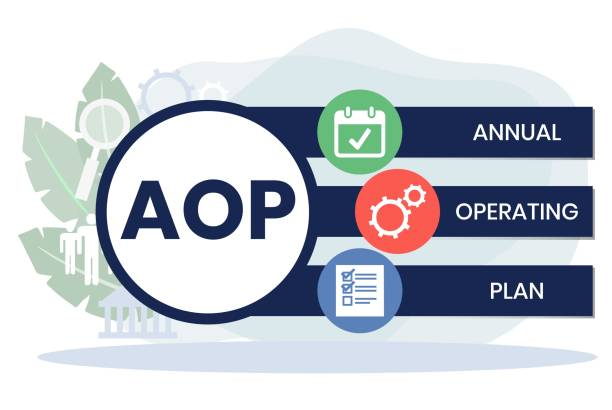When it comes to financial planning and management within an organization, the term “AOP” or Annual Operating Plan is one of the keystones. Understanding what is AOP in finance is crucial for stakeholders at all levels, from executives and managers to individual department heads. An AOP outlines a company’s financial goals and the detailed plan of action for the upcoming fiscal year, based on the broader strategic objectives of the organization.
In essence, what is AOP in finance involves projecting revenues, planning expenses, and aligning them with the company’s strategic goals. It serves as a roadmap that guides a company through its fiscal year, ensuring that all departments are working in unison towards common financial goals.
Key Elements of an Annual Operating Plan
The construction of an AOP involves several critical elements that combine to form a cohesive plan:
Revenue Forecasting
Revenue forecasting is a foundational aspect of the AOP, involving detailed predictions about the company’s anticipated income streams from diverse sources. These sources typically include:
- Sales Revenue: Projections for sales of products or services based on market trends, historical data, and sales forecasts.
- Service Revenue: Anticipated revenue generated from services offered by the company, such as consulting, maintenance, or subscriptions.
- Other Income: Additional sources of income beyond core business operations, such as interest income, licensing fees, or royalties.
Accurate revenue forecasting provides insight into expected cash flows, informs strategic decisions regarding sales targets, pricing strategies, and resource allocation, and serves as a basis for financial planning and performance evaluation.
Expense Budgeting
Expense budgeting entails comprehensive planning for anticipated costs and expenditures incurred by the organization. This encompasses various expense categories, including:
- Salaries and Benefits: Allocation of funds for employee wages, bonuses, benefits, and payroll taxes.
- Marketing Expenses: Budgeting for advertising, promotions, market research, branding initiatives, and digital marketing campaigns.
- Research and Development (R&D): Investment in innovation, product development, technological advancements, and intellectual property.
- Overhead Costs: Provision for administrative expenses, rent, utilities, insurance, and other overheads essential for business operations.
By meticulously budgeting expenses, organizations can ensure financial discipline, optimize resource utilization, and maintain profitability margins, while also facilitating cost control measures and strategic investment decisions.
Resource Allocation
Effective resource allocation involves determining how financial, human, and operational resources will be distributed among different departments and initiatives to maximize efficiency and productivity. This process includes:
- Capital Allocation: Allocating funds for strategic investments, capital projects, acquisitions, or expansion initiatives aimed at enhancing long-term growth and competitiveness.
- Human Resource Allocation: Optimizing staffing levels, skill sets, and workforce deployment to align with business objectives, operational demands, and talent development strategies.
- Operational Resource Allocation: Allocating resources such as inventory, equipment, and facilities to support core business activities, strategic initiatives, and operational excellence initiatives.
Strategic resource allocation ensures that resources are allocated in accordance with organizational priorities, enabling optimal performance, agility, and adaptability to dynamic market conditions.
Risk Management
Risk management is integral to the AOP process, involving the identification, assessment, and mitigation of potential risks that may impact the achievement of organizational goals. Key aspects of risk management include:
- Risk Identification: Identifying internal and external factors that pose risks to business operations, financial stability, or reputation, through techniques such as risk assessments, scenario analysis, and environmental scanning.
- Risk Assessment: Evaluating the likelihood and potential impact of identified risks to prioritize mitigation efforts and allocate resources effectively, considering factors such as risk severity, frequency, and vulnerability.
- Risk Mitigation Strategies: Developing proactive measures and contingency plans to mitigate identified risks, minimize losses, and capitalize on opportunities, through strategies such as risk avoidance, risk reduction, risk transfer, or risk acceptance.
Effective risk management enhances resilience, safeguards assets, and preserves shareholder value, fostering a culture of prudent decision-making, accountability, and risk awareness across the organization.
Performance Metrics
Establishing clear performance metrics is essential for monitoring progress, evaluating outcomes, and facilitating data-driven decision-making throughout the fiscal year. Key performance metrics may include:
- Financial Metrics: Metrics such as revenue growth, profitability margins, cash flow, and return on investment (ROI) provide insights into financial performance, sustainability, and shareholder value creation.
- Operational Metrics: Metrics related to operational efficiency, productivity, quality, customer satisfaction, and market share help assess the effectiveness of business processes, resource utilization, and operational excellence initiatives.
- Strategic Metrics: Metrics aligned with strategic objectives, such as market penetration, product innovation, customer acquisition, and brand perception, measure progress towards long-term goals, competitive positioning, and market leadership.
By tracking performance metrics regularly, organizations can identify trends, assess deviations from targets, and take timely corrective actions to optimize performance, mitigate risks, and drive continuous improvement and innovation.
Review and Adjustment
Continuous review and adjustment are critical components of the AOP process, enabling organizations to adapt to changing market dynamics, business conditions, and performance trends. This involves:
- Periodic Reviews: Conducting regular reviews of financial performance, operational metrics, and market dynamics to assess the alignment of the AOP with evolving circumstances, identify emerging risks and opportunities, and inform strategic decision-making.
- Performance Analysis: Analyzing variances between planned targets and actual performance to identify areas of strength, weakness, and opportunities for improvement, through techniques such as variance analysis, trend analysis, and root cause analysis.
- Adjustment Strategies: Developing flexible strategies and contingency plans to address deviations from the AOP, reallocate resources, and capitalize on emerging opportunities, while ensuring alignment with organizational goals, values, and priorities.
By fostering agility, responsiveness, and learning, continuous review and adjustment enhance the relevance and effectiveness of the AOP, ensuring its alignment with organizational goals and market realities, and enabling sustained growth, competitiveness, and resilience in dynamic and uncertain environments.
The Process of Developing an AOP

Creating an effective Annual Operating Plan is a dynamic process that requires careful consideration and involves several key steps:
Strategic Review
Before commencing the development of the AOP, it is essential to conduct a strategic review of the company’s long-term goals and objectives. This involves:
- Assessing the company’s mission, vision, and core values.
- Analyzing market dynamics, competitive landscape, and industry trends.
- Identifying strategic priorities, growth opportunities, and potential challenges.
- Aligning financial objectives with broader organizational goals and strategies.
The strategic review sets the foundation for the AOP development process, providing clarity on overarching objectives and guiding principles.
Data Collection
Gathering relevant data is crucial for informed decision-making and accurate forecasting. The data collection process involves:
- Compiling historical financial data, including sales, expenses, profitability, and cash flow statements.
- Analyzing market data, such as customer demographics, demand trends, and competitive benchmarks.
- Collecting input from internal stakeholders, including sales teams, finance department, and operations managers.
- Utilizing external data sources, such as economic indicators, industry reports, and market research studies.
Comprehensive data collection ensures that the AOP is based on sound analysis and reflects current market conditions and internal capabilities.
Stakeholder Input
Involving input from all relevant stakeholders is essential for building consensus, fostering buy-in, and ensuring the plan’s comprehensiveness. Stakeholder input may include:
- Input from department heads, managers, and key personnel across various functional areas.
- Feedback from customers, suppliers, and business partners regarding market dynamics and expectations.
- Collaboration with finance professionals, including financial analysts, budget managers, and controllers.
- Engagement with senior leadership, including the CEO, CFO, and board of directors, to align financial goals with strategic priorities.
By soliciting input from diverse stakeholders, organizations can gain valuable insights, identify potential blind spots, and enhance the relevance and effectiveness of the AOP.
Drafting the Plan
Once all relevant data and stakeholder inputs have been gathered, the next step is to draft the AOP. This involves:
- Consolidating financial forecasts, including revenue projections, expense budgets, and capital expenditure plans.
- Integrating strategic initiatives, operational goals, and performance targets into the plan.
- Documenting assumptions, methodologies, and key drivers underlying the financial projections.
- Developing scenario analyses and sensitivity models to assess the impact of various market scenarios on financial performance.
The drafting phase aims to synthesize all inputs into a cohesive and actionable plan that aligns with the company’s strategic framework and financial objectives.
Review and Revision
Following the initial drafting of the AOP, the plan undergoes multiple rounds of review and revision to ensure accuracy, feasibility, and alignment with organizational goals. This process includes:
- Conducting thorough reviews of financial forecasts, operational plans, and strategic initiatives.
- Seeking feedback from stakeholders and subject matter experts to identify potential gaps or areas for improvement.
- Iteratively refining assumptions, adjusting projections, and recalibrating targets based on feedback and changing market conditions.
- Incorporating risk mitigation strategies and contingency plans to address potential uncertainties and challenges.
The review and revision phase is critical for refining the AOP and enhancing its robustness, realism, and alignment with organizational priorities.
Final Approval
The final step in the AOP development process is obtaining approval from top management and the board of directors. This involves:
- Presenting the finalized AOP to key stakeholders, including senior executives and board members.
- Justifying assumptions, outlining strategic rationale, and articulating the expected outcomes of the plan.
- Addressing any concerns or questions raised during the review process and demonstrating alignment with strategic objectives and financial targets.
- Securing formal approval and endorsement of the AOP, along with any associated budgets, resource allocations, or capital investments.
Final approval signifies organizational commitment to the AOP and provides the mandate for its implementation and execution.
Benefits of Implementing an AOP

The implementation of a well-structured AOP offers numerous benefits:
Alignment of Goals
Implementing an AOP ensures that all departments are working harmoniously towards the attainment of shared financial objectives. This alignment fosters cohesion and synergy across the organization, driving collective efforts towards strategic outcomes.
- Enhanced collaboration and teamwork: A cohesive alignment of goals promotes collaboration and teamwork among departments, facilitating cross-functional cooperation and knowledge sharing.
- Minimized conflicts and duplication of efforts: Clear alignment reduces conflicts arising from competing priorities, minimizing duplication of efforts and resources across departments.
- Improved coordination of resources: With aligned goals, resources can be allocated more efficiently, optimizing resource utilization and enhancing overall productivity.
- Increased focus on strategic priorities: Aligning departmental goals with organizational objectives ensures that efforts are directed towards activities that contribute most effectively to the achievement of strategic priorities.
Improved Financial Management
A well-structured AOP enhances financial management practices by providing a framework for tracking performance, allocating resources, and making informed decisions to optimize financial outcomes.
- Greater transparency and accountability: The AOP fosters transparency and accountability by clearly outlining financial objectives, performance targets, and resource allocations, promoting a culture of openness and responsibility.
- Enhanced decision-making based on real-time data: By tracking financial performance against predetermined targets, decision-makers can make informed decisions based on real-time data, leading to improved outcomes and resource allocation.
- Improved cash flow management: With a detailed AOP in place, organizations can better forecast cash flows, anticipate funding needs, and manage liquidity effectively, reducing the risk of cash flow shortages and financial instability.
- Better allocation of capital resources: The AOP enables organizations to prioritize capital investments based on strategic objectives and financial performance, ensuring optimal allocation of resources to projects with the highest return on investment and alignment with long-term goals.
Enhanced Communication
AOP implementation fosters better communication within the company by providing a clear plan of action, thereby promoting transparency, alignment, and shared understanding of organizational goals and priorities.
- Improved employee engagement and morale: Clear communication of goals and expectations increases employee engagement and morale, leading to higher levels of motivation, productivity, and job satisfaction.
- Reduced ambiguity and misunderstanding: By clearly articulating goals, strategies, and expectations, the AOP reduces ambiguity and misunderstanding, leading to smoother execution of plans and initiatives.
- Alignment of individual efforts with organizational goals: Employees understand how their individual contributions contribute to the overall success of the organization, leading to greater alignment of efforts with organizational goals and objectives.
- Enhanced stakeholder trust and confidence: Transparent communication of financial plans and performance instills trust and confidence among stakeholders, including employees, investors, customers, and partners, fostering stronger relationships and support for organizational initiatives.
Proactive Risk Management
AOP implementation enables organizations to anticipate and mitigate potential risks in advance, thereby enhancing resilience, minimizing disruptions, and protecting organizational assets.
- Reduced exposure to financial and operational risks: The AOP incorporates risk assessment and mitigation strategies, helping organizations identify and address potential risks before they escalate into significant issues, reducing exposure to financial losses and operational disruptions.
- Enhanced business continuity and resilience: By proactively addressing risks, organizations can maintain business continuity, minimize disruptions, and recover more quickly from adverse events, ensuring ongoing operations and safeguarding stakeholder interests.
- Greater stakeholder confidence and trust: Stakeholders have greater confidence in organizations that demonstrate proactive risk management practices, leading to enhanced trust, credibility, and support for organizational initiatives and investments.
- Improved ability to capitalize on opportunities: By identifying and addressing potential risks, organizations are better positioned to capitalize on emerging opportunities and gain a competitive advantage in the marketplace, enabling sustainable growth and long-term profitability.
Strategic Agility
AOP implementation enables organizations to remain agile and adapt quickly to unforeseen changes or opportunities, thereby maintaining a competitive edge and driving sustainable growth in dynamic and uncertain environments.
- Faster response to market opportunities and threats: With a well-defined AOP, organizations can quickly adjust their strategies and operations in response to changing market dynamics, allowing them to capitalize on opportunities and mitigate threats more effectively, maintaining market relevance and competitiveness.
- Enhanced innovation and adaptability: By fostering a culture of strategic agility, the AOP encourages innovation, experimentation, and continuous improvement, enabling organizations to adapt to evolving customer needs, market trends, and technological advancements, driving innovation and competitiveness.
- Improved competitive positioning: Organizations that can adapt quickly to changes in the marketplace are better positioned to maintain a competitive edge and seize market opportunities ahead of their competitors, driving market share growth, revenue expansion, and profitability.
- Sustainable growth and profitability: Strategic agility enables organizations to navigate uncertainties and challenges more effectively, leading to sustainable growth, profitability, and long-term value creation for shareholders, employees, customers, and other stakeholders.
Real-World Application and Examples
In practical terms, many successful companies attribute part of their success to effective AOPs. For example, a leading tech company might project a 20% increase in revenue based on new product launches and expanded market reach, detailed in their AOP. Similarly, a manufacturing firm may plan significant reductions in operational costs by implementing new technologies, as outlined in their Annual Operating Plan.
These real-world examples show what is AOP in finance in action, demonstrating its significance in guiding companies towards achieving their financial goals.
Conclusion
Understanding what is AOP in finance is essential not just for financial professionals but also for anyone involved in strategic planning within a business. It helps in setting realistic goals, managing resources effectively, and aligning various departments towards common objectives, thereby paving the way for sustained financial health and business growth.
FAQ
While an AOP includes a budget, it is more comprehensive and includes strategic plans, revenue forecasts, and other elements that are not typically part of a budget.
It should be reviewed quarterly to make necessary adjustments based on actual performance and changing circumstances.
Typically, it involves top management, finance teams, department heads, and sometimes even board members.
Yes, even small businesses can benefit significantly from creating and following an AOP, as it helps in strategic financial planning and management.



